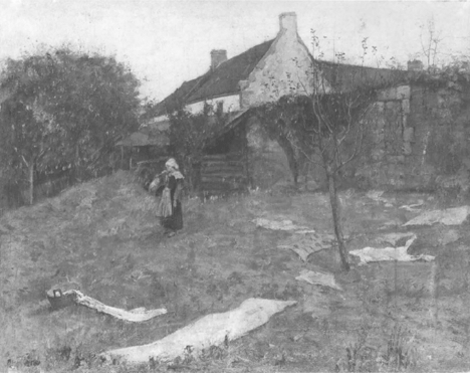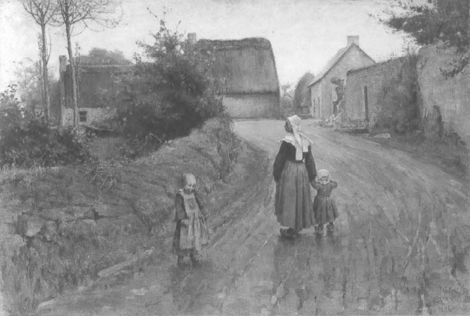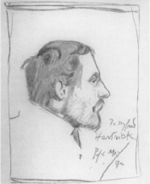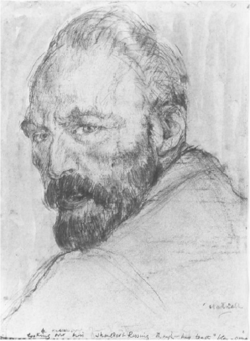Van Gogh Museum Journal 2001
(2001)– [tijdschrift] Van Gogh Museum Journal–
[pagina 96]
| |
 fig. 1
A.S. Hartrick, Gauguin's studio, Pont-Aven, 1886, London, Courtauld Institute Gallery | |
[pagina 97]
| |
Memories of Van Gogh and Gauguin: Hartrick's reminiscences
| |
From Bangalore to BrittanyA.S. Hartrick was born in Bangalore, India, on 7 August 1864, the son of a British army captain. Two years later his family returned to their native Scotland. Hartrick later studied at the Slade School in London under Alphonse Legros (1884-85), and then went to Paris, initially attending the Académie Julian. During the summer of 1886, probably in June, he travelled to Pont-Aven, to work in the small Breton port. There he stayed at the Pension Gloanec, meeting many of the other painters who flocked to this new artist's haven. In November he returned to Paris and the following month entered the Atelier Cormon. He worked in Paris for a year, encountering many avant-garde artists, and at the end of 1887 he returned to Scotland. Hartrick's Pont-Aven paintings have remained relatively unknown, but two key works were acquired by the Courtauld in 2000: Gauguin's studio, Pont-Aven and Village street, Pont-Aven, both dating from 1886.Ga naar voetnoot1 They were donated by Miss Eva A. Black, a niece of the artist who lived in Scotland and who died in 2001, aged 98.Ga naar voetnoot2 The two paintings are fairly traditional in style, particularly the road scene, and owe little to the influence of Gauguin and the nascent Pont-Aven School. Gauguin's studio, Pont-Aven (fig. 1) depicts the exterior of the Manoir de Lezaven, where an atelier extension | |
[pagina 98]
| |
 fig. 2
A.S. Hartrick, Village street, Pont-Aven, 1886, London, Courtauld Institute Gallery | |
[pagina 99]
| |
had been built in 1865.Ga naar voetnoot3 The studio is in the centre of the painting (just the upper part of its white wall is visible beneath the roof). In the foreground is a girl wearing a Pont-Aven costume of the period, and washed linen is drying on the grass. Hartrick does not focus on the buildings, but on the setting, and it was probably only later that he entitled the picture Gauguin's studio. Indeed, the painting could well be his Blanchissage Breton, shown at the Paris Salon in 1887. The studio building was never depicted by Gauguin, nor, apparently, in detail by any other 19th-century artists, and there are no early photographs.Ga naar voetnoot4 This therefore appears to be the best visual record of the place during Gauguin's period, although the building does still survive. Village street, Pont-Aven (fig. 2) depicts a road, with a woman and two little girls walking towards a group of farmhouses.Ga naar voetnoot5 The location has not been identified, and it probably shows houses which have since disappeared. The costumes are typical of those worn in Pont-Aven in the 1880s. When the painting was exhibited in 1936, the Fulham Chronicle recorded a story that presumably came from Hartrick: ‘During the painting of this [work] the artist was actually stoned by the resentful Breton villagers! It was only the timely intervention of the priest from Nizon that prevented this exhibition from being robbed of one of its pleasantest pictures.’Ga naar voetnoot6 The assistance of the Nizon priest suggests that the painting may have been done on the road to the small village, which lies three kilometres to the west of Pont-Aven. The priest was probably Hippolyte Orvoën, who served from 1886-89. The reference to him is intriguing, since in September 1888 Gauguin wanted to present him with his Vision after the sermon (Edinburgh, National Galleries of Scotland) for the Nizon church, but it was rejected.Ga naar voetnoot7 Following his departure from France, Hartrick settled into a much more conventional milieu in Britain. In 1890 he became an illustrator for the Daily Graphic in London, where he worked for two years. One of his fellow illustrators, Philip May (1863-1903), drew his portrait in 1892 (fig. 3). In 1896 Hartrick married the artist Lily Blatherwick (1854-1934), who was his stepsister, and the couple moved to the Gloucestershire countryside for a fig. 3
Phil May, Portrait of Hartrick, 1892, present location unknown (reproduced in A painter's pilgrimage, p. 102) | |
[pagina 100]
| |
decade, initially to Acton Turville and then to Tresham, before eventually returning to London. From the late 1890s he worked mainly as an illustrator and printmaker, and in 1909 he was a founding member of the London-based Senefelder Club, named after the inventor of lithography. He was also elected an associate of the Royal Watercolour Society in 1910 and a full member ten years later. Hartrick taught drawing and painting at London's Camberwell School of Art (1908-14) and lithography at the Central School (1914-29). He illustrated numerous books and wrote studies on drawing and lithography.Ga naar voetnoot8 Hartrick died on 1 February 1950.Ga naar voetnoot9 | |
ReminiscencesAlthough Hartrick recorded his memories of Van Gogh and Gauguin in his autobiography, A painter's pilgrimage through fifty years, they have never been taken particularly seriously, mainly because they were not published until 1939 - 53 years after he had known the artists in France.Ga naar voetnoot10 The author also admitted in the introduction to his book that it was not based on documentary material: ‘I kept no diary; and although I have looked at some papers and letters, I preferred not to burden what I wished to say with details already forgotten.’Ga naar voetnoot11 I have, however, tracked down evidence that Hartrick's reminiscences of Van Gogh and Gauguin were recorded before the First World War, i.e. more than a quarter of a century before the publication of his autobiography. A paper entitled ‘Post-impressionism, with some personal recollections of Vincent Van Gogh and Paul Gauguin’ survives in three forms. First, it was published in the May 1913 issue of The Imprint, a London journal primarily devoted to typography and printmaking.Ga naar voetnoot12 This was a very short-lived venture, and only nine issues appeared before it ceased publication. The article does not appear to have been cited in any of the subsequent literature on either Van Gogh or Gauguin. Secondly, the same text was privately reprinted as a slim 24-page book, Post-impressionism, with some personal recollections of Vincent Van Gogh & Paul Gauguin. At the back of the book is an explanatory colophon: ‘Printed at the L.C.C. [London County Council] Central School of Arts & Crafts by the Day Technical School of Book Production. Teacher J.H. Mason. 1916.’ The book is extremely rare and it is neither in the British Library nor in the UK National Art Library.Ga naar voetnoot13 The three extant copies can be found in the archive of the Central St Martin's School of Art. Each is bound differently, and they were apparently preserved as examples of books typeset and bound by students, rather than for their content. Finally, a 29-page typescript of the text of Hartrick's paper also survives in the college archive.Ga naar voetnoot14 | |
[pagina 101]
| |
In preparing his 1913 paper, Hartrick had probably been spurred on by the controversial ‘Manet and the Post-Impressionists’ exhibition, held at London's Grafton Galleries from November 1910 to January 1911. Twenty-three works by Van Gogh and 21 by Gauguin had been on show, giving the British public their first real taste of the paintings of these two artists. Visiting the exhibition must have reawakened Hartrick's interest in his old colleagues, and friends probably encouraged him to record his memories.Ga naar voetnoot15 When in 1939 he came to publish his autobiography, he presumably took his 1913 essay, added further details and expanded it with secondary material.Ga naar voetnoot16 The fact that Hartrick's reminiscences actually date from 1913 means that scholars should take them far more seriously than has previously been the case. Not only were they recorded considerably closer to the time when he had known the two painters, but there are other reasons to suggest that the author's recollections are, in fact, trustworthy. In 1913 relatively little material had been published on Gauguin and Van Gogh, so Hartrick's account would have been much less coloured by the writings of others.Ga naar voetnoot17 The two artists were not nearly as famous as they were to become, meaning Hartrick would have had less incentive to exaggerate his links with them - in contrast to 1939, when his publisher is likely to have encouraged him to stress this aspect in his autobiography. Hartrick's 1913 memoirs are particularly important because they cover periods in the life of the two post-impressionists that are relatively less well documented. Van Gogh was living with his brother Theo in Paris and therefore not in correspondence with him. The only other significant personal account of Gauguin's first visit to Pont-Aven in 1886 was written by the artist Henri Delavallée (1862-1943), whose brief recollections were published by Charles Chassé in 1921.Ga naar voetnoot18 Despite later critical comments regarding the reliability of Hartrick's autobiography, a detailed examination of his 1913 essay suggests that they are relatively accurate. The text not only provides a revealing insight into the personalities of the two artists, but also sometimes helps in the dating of works and chronology. | |
Memories of GauguinHartrick spent the summer of 1886 at Pont-Aven, probably arriving in June or possibly early July. He was certainly there when Gauguin arrived on 25 July.Ga naar voetnoot19 Both men lodged at the Pension Gloanec, a favourite haunt of visiting artists in the central square of the village. Hartrick recalled his initial impression of Gauguin: ‘Tall, dark, rather handsome, with a fine powerful figure, and about forty years of age, wearing a blue jersey, and a beret on the | |
[pagina 102]
| |
side of his head, is how I saw him first.’Ga naar voetnoot20 In terms of personality, he found him ‘self-contained, confident, silent, almost dour.’ Hartrick recounted an incident which took place during one of their first encounters: ‘Gauguin, a few days after his arrival and more or less a complete stranger, was passing through the little crowd of painters standing round the door of the Auberge, waiting for dejeuner. He was carrying a sketch, on which he had just been working, representing some nude boys bathing on a weir, painted in the now familiar “impressionist” manner, all spots in touches of pure colour.’Ga naar voetnoot21 Gauguin was immediately ridiculed by a Dutch artist also staying at the pension, and a crowd quickly gathered. Hartrick discreetly refers to him only as V, short for Hubert Vos (1855-1935).Ga naar voetnoot22 Hartrick then recounts what happened two weeks later. A pupil of Vos's, named only as P, switched his allegiance and began to go to Gauguin for instruction. P is presumably Ferdinand du Puigaudeau (1864-1930), then 22 and nicknamed Piccolo.Ga naar voetnoot23 In his 1924 Leicester Galleries catalogue essay on Gauguin, Hartrick added that P ‘invited his new master to share a studio he had taken at les Avens [Lezaven], and there Gauguin worked in comfort for the rest of his time at Pont-Aven.’Ga naar voetnoot24 This comment is interesting, since it has usually been assumed that Gauguin only began using the Lezaven studio on his third visit to Pont-Aven in 1889, returning there again in 1894. The Lezaven house was owned by Marie-Perrine Lollichon, whose son, Louis Bergé, was then the village mayor. It is located on a hillside, 200 metres from the west bank of the River Aven, and Gauguin frequently painted in the nearby Champ Derout-Lollichon. Another of Hartrick's anecdotes provides an insight into Gauguin's attitude towards drawing. Gauguin compared some studies of geese he had made with those of the English illustrator, Randolph Caldecott (1846-1886), who had visited Pont-Aven in the 1870s. Hartrick recounted: ‘I remember one interesting conversation with him [Gauguin], in which he expressed great admiration for the drawings of Randolph Caldecott, whose children's books he had. That, he said, was real drawing expressive of character and of life, as distinct from the machines made in the studio.’Ga naar voetnoot25 In his 1924 essay, Hartrick also recalled a lost work which Gauguin had made for the Pension Gloanec: ‘I remember he painted a panel for the dining-room of the Auberge, an autumn landscape, which appeared to most of us who fed there as being very extreme in its crude exaggeration of purple and gold; though of course it was nothing to what we were soon to become accustomed to.’Ga naar voetnoot26 Hartrick noted that although ‘I never knew Gauguin intimately, I saw him daily at the Auberge Gloanec for | |
[pagina 103]
| |
three or four months, and heard him talk.’ At the time Hartrick also knew Charles Laval (1862-1894) and Du Puigaudeau, and ‘from these two I gathered, vicariously, perhaps more about him [Gauguin] than I should probably have arrived at on my own.’Ga naar voetnoot27 However, Hartrick admitted that he did not get to know Gauguin ‘in anything like the way I knew Van Gogh,’ since Gauguin was ‘a much more reserved and difficult person to become intimate with.’Ga naar voetnoot28 Gauguin returned to Paris on around 13 October and Hartrick left in late November.Ga naar voetnoot29 | |
Memories of Van GoghIt was in Paris that Hartrick was introduced to Van Gogh, through their mutual friend, the Australian artist John Russell (1858-1934). Russell had been in Paris since early 1885 and had joined the Atelier Cormon, where he later got to know Van Gogh. Hartrick first met Vincent at Russell's apartment, at 15 impasse Hélène, off avenue de Clichy.Ga naar voetnoot30 Shortly afterwards, Russell left for a visit to Sicily, renting his studio to Hartrick and the British artist Henry Ryland (1856-1924). At this point Van Gogh and Gauguin had not yet met, but it is possible that Hartrick told Van Gogh about his contact with Gauguin in Pont-Aven. In 1939 Hartrick recalled: ‘all through the early part of 1887, Vincent frequently came to see me in the Impasse Hélène, to the horror of poor Ryland.’Ga naar voetnoot31 They also sometimes met at Theo's apartment at 54 rue Lepic, where Vincent was staying. ‘I have been to his rooms with him (I think they really belonged to his brother). Anyway he seemed to be living quite comfortably and showed me some very good Japanese prints, besides some lithographs and etchings by Matthew Maris, with whom he seemed to be very friendly.’Ga naar voetnoot32 Hartrick also reported Van Gogh's anger at not being able to sell his paintings, despite Theo's important position with Goupil: ‘He did not sell any of his work at that time, and used to rage from time to time that though connected with the picture trade no one would buy anything he did.’Ga naar voetnoot33 Hartrick was particularly struck by Van Gogh's interest in complementary colours: ‘He used to carry in either pocket a large lump of blue and red chalk: with these he was always ready to illustrate his theories on whatever was handy.’Ga naar voetnoot34 Hartrick was concerned that Van Gogh might damage Russell's apartment, so ‘as soon as he came in, I placed a newspaper or two conspicuously on the table, and on these he illustrated his themes or theories quite cheerfully, with lines of blue or red chalk at least a quarter of an inch thick.’Ga naar voetnoot35 | |
[pagina 104]
| |
 fig. 4
A.S. Hartrick, Portrait of Van Gogh, 1930s, Amsterdam, Van Gogh Museum (Vincent van Gogh Foundation) Van Gogh's ideas on light and colour made a deep impression on Hartrick: ‘He was particularly pleased with a theory that the eye carried a portion of the last sensation it had enjoyed into the next [...] the entering of a lamplit room out of the night increases the orange effect of light and in the contrary case, the blue. Hence, to depict it properly, according to the theory, it is necessary in the former case to include some blue in the picture and in the latter some orange. Van Gogh used to roll his eyes and hiss through his teeth with gusto, bring out the words “blue”, “orange”, complementary colours, of course.’Ga naar voetnoot36 In his 1913 memoir, Hartrick also gives an interesting description of his friend: ‘Van Gogh was a rather weedy little man, with pinched features, sandy hair and beard, and a light blue eye. He had an extraordinary trick of pouring out sentences in a mixture of Dutch, English, and French, then glancing quickly at you over his shoulder and hissing through his teeth as he finished a series. In fact, when excited, he looked more than a little mad: and this look Russell had caught exactly.’Ga naar voetnoot37 Hartrick also provides a fascinating insight into Vincent's character. Van Gogh was ‘extraordinarily sensitive to physical impressions, specially those of brightness or light. He was always in a state of wild excitement to explain to some one else the pleasure - or pain if you like - that he had received from something he had seen or imagined.’Ga naar voetnoot38 Hartrick then makes some perceptive comments about his friend's spontaneity: ‘Whatever Van Gogh got, he took from nature directly and on the spur of the moment, guided by a sort of instinct, like a dog on the scent of a trail [...]. In most aspects Van Gogh was personally as simple as | |
[pagina 105]
| |
a child, expressing pleasure and pain loudly in a child-like manner. The direct way in which he showed his likes and dislikes was sometimes very disconcerting, but quite without malice or any conscious knowledge that he was giving offence.’Ga naar voetnoot39 There has been considerable discussion about when exactly Van Gogh studied at the Atelier Cormon, but Hartrick recalled that he knew him ‘about six months after he had left [there].’Ga naar voetnoot40 Hartrick then recounted an incident which is said to have involved a row between Cormon and his then-student Emile Bernard: ‘The story goes that Van Gogh, in great indignation, went round with a pistol to shoot Cormon, so much had he taken to heart this interference with the free expression of the individual.’Ga naar voetnoot41 Bernard was indeed expelled from the studio, but Van Gogh's supposed violent reaction is unlikely to have occurred and is not recorded by any of the other students. Hartrick also deliberately distances himself from this detail, stating that it was merely ‘a story,’ which had occurred before he had known Van Gogh. This appears to be the only time in his account of the two post-impressionists when Hartrick repeats a rumour. Hartrick ended his reminiscences by concluding: ‘I frankly confess that neither myself, nor any of those I remember about me, imagined at that time that Van Gogh would be talked of as a great genius a few years later. We thought him a little cracked, but harmless, interesting, and certainly amusing at times. Always an artist in temperament, we thought his work too rudimentary and apparently unskilful in handling to appeal to us as students, many of whom could surpass it from that point of view.’Ga naar voetnoot42 Hartrick left Russell's accommodation when the Australian returned from Sicily, following the tragic death of Russell's infant son, Jean. ‘I had to move out and go to a hotel for the remainder of my time in Paris, and with this move I lost touch with Vincent.’ Hartrick himself left Paris at the end of 1887.Ga naar voetnoot43 Decades later, Hartrick drew portraits of both Van Gogh and Gauguin. These date from the 1930s, and were probably done for reproduction in A painter's pilgrimage. Hartrick made an ink and watercolour sketch of Van Gogh (fig. 4), which was published as the frontispiece of the autobiography. The Van Gogh Museum acquired the original work in 1997. Hartrick also did two portraits of Gauguin, one now lost and the other at the Glasgow Art Gallery.Ga naar voetnoot44 These works were probably based mainly on secondary sources (the John Russell portrait of Van Gogh and photographs or self-portraits of Gauguin), although they still give a very personal view of the two artists. Despite the fact that they were made half a century after his encounters with them, they may still be considered Hartrick's homage to the two painters he had known as a young man. |
|

